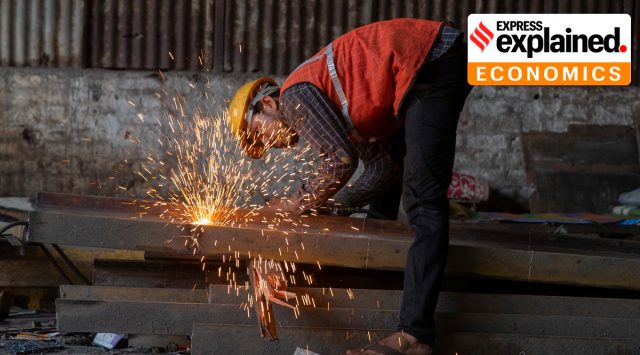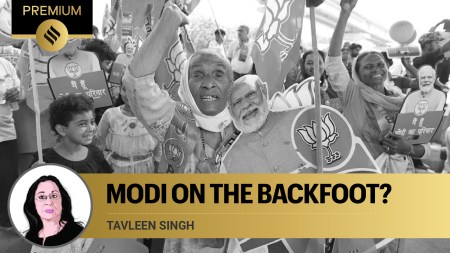- India
- International
Explained: Why has Moody’s upgraded India’s sovereign rating outlook?
Moody's has changed India's sovereign rating outlook from 'negative' to 'stable'. What led to the upgrade, and what is its assessment on India's growth?
 A worker welds an iron beam at a construction site near a railway station in Mumbai, India, Tuesday, Oct. 5, 2021. (AP Photo/Rafiq Maqbool)
A worker welds an iron beam at a construction site near a railway station in Mumbai, India, Tuesday, Oct. 5, 2021. (AP Photo/Rafiq Maqbool)Asserting that India’s downside risks from negative feedback between real economy and financial system are receding, ratings agency Moody’s on Tuesday changed India’s sovereign rating outlook from ‘negative’ to ‘stable’, while affirming the country’s foreign-currency and local-currency long-term issuer ratings at Baa3. Last year, Moody’s downgraded India’s sovereign rating from ‘Baa2’ to ‘Baa3’, the lowest investment grade, saying there will be challenges in implementation of policies to mitigate risks of a sustained period of low growth and deteriorating fiscal position. The outlook on the rating was kept negative.
What led to an upgrade in the rating agency’s outlook?
With higher capital cushions and greater liquidity, banks and non-bank financial institutions pose much lesser risk to the sovereign than Moody’s previously anticipated. And while risks stemming from a high debt burden and weak debt affordability remain, Moody’s expects that the economic environment will allow for a gradual reduction of the general government fiscal deficit over the next few years, preventing further deterioration of the sovereign credit profile.
“Bank provisioning has allowed for the gradual write-off of legacy problem assets over the past few years. In addition, banks have strengthened their capital positions, pointing to a stronger outlook for credit growth to support the economy,” Moody’s said.
What steps have been taken to strengthen the banking system?

In the last six financial years, banks have recovered Rs 5.01 lakh crore of bad loans, enabling them to improve their financial metrics. The government has infused Rs 3.06 lakh crore in state-owned banks in five years between 2017-18 and 2021-22, and taken a series of reforms to strengthen banks, improve debt resolution and recovery.
Last month, the government approved extending a guarantee of Rs 30,600 crore to the National Asset Reconstruction Company Ltd (NARCL) to help clear the banking sector’s stressed assets of around Rs 2 lakh crore in a time-bound manner.
What is Moody’s assessment on growth?
Following a deep contraction of 7.3 per cent in the fiscal year ending March 2021, India’s real GDP is expected to surpass 2019 levels this fiscal year, rebounding to a growth rate of 9.3 per cent, followed by 7.9 per cent in fiscal 2022, it said. Looking ahead, Moody’s expects real GDP growth to average around 6 per cent over the medium term, the report said. Some analysts argued that Moody’s has underestimated India’s potential of real GDP expansion in the medium term, as there are enough levers in place for a higher growth.
What is the impact of the upgrade?
Since overseas borrowing costs are tied to a country’s rating and the agencies’ outlook on the nation, an upgrade usually helps in lowering borrowing costs for the government as well as the corporate sector. With chances of default receding and improvement in overall debt service ability, foreign investors take comfort in subscribing to government and corporate bonds at lower rates.
Newsletter | Click to get the day’s best explainers in your inbox
More Explained
EXPRESS OPINION
May 15: Latest News
- 01
- 02
- 03
- 04
- 05








































